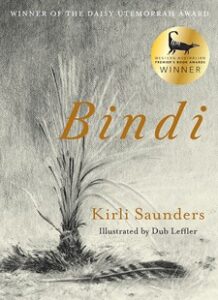Welcome to 2021, and the return of the monthly roundups. What a year it has been, with fires, floods and COVID. With 2021 starting with much uncertainty, I wasn’t sure what the numbers would bring. So it is a slow start to the year, perhaps due to fatigue with lockdowns and restrictions, but we have started out quite well, with ten children’s and younger readers books reviewed, and three reviews for young adult, with two of those for the same book. 2021 could possibly have a similar trend towards books aimed at readers aged between three and twelve, up to middle grade books, so this will be interesting to see as the year progresses. I would personally love to read the backlog of YA on my shelves, and am hoping to keep on top of all the review copies I am sent.
This month, we had a good spread across novels and picture books for younger readers. Bindi by Kirli Saunders was reviewed twice – by Nadia L King and Lauren at Underground Writers. Nadia, who isn’t usually a fan of verse novels like Bindi, says that she loved the simplicity of language and the way the words spoke to the reader to convey Bindi’s life, and what happens when fire threatens Bindi’s community. Nadia recommends this book, and says the simple language is what makes it beautiful and allows the story to speak for itself. Lauren focuses on the role of language and the combination of English and Gundungurra Language, and the role the glossary plays in helping readers learn and understand the language, but also the role that writing towards a decolonisation within the story plays in allowing Indigenous children to see themselves reflected, whilst others can seamlessly earn language without in text translations.
Whispering Gums reviewed Cooee Mittigar by Jasmine Seymour and Leanne Mulgo, a picture book that introduces readers of all ages to Darug Country and language – this sounds like an ideal way to introduce non-Indigenous readers to country and language, especially if you don’t quite know what you’re looking for to start you off. It tells the story of the seasons, as they are understood by the Darug people – another good way to introduce Indigenous history and culture. History of all kinds can be overwhelming and sometimes, you need just the right book to get you started, and it sounds like this is one of those books. Whispering Gums comments on the willingness of these communities to share through books like this, to pass on knowledge and language – not only to keep it alive, but to hopefully, bridge those gaps and help non-Indigenous people understand, even when tehre are many who may not want to. In contrast to Bindi, Seymour and Mulgo have managed to seamlessly include both languages and translations across a two-page spread, making the book engrossing and educational at the same time, and work together with the illustrations to make the text and story dance off the page. This book also has a glossary at the end with a pronunciation guide for the Darug words – this is a good educational tool for all ages, and all people trying to learn language and gain an understanding of the lands they walk on. Whispering Gums’ informative review is delicately and respectfully worded, whilst also giving non-Indigenous people an idea of what to expect, and an understanding of how to interact with this book and with its language.
As the editor of this round up, I also completed the Friday Barnes series, and will include my review for book nine in the February post.
It was a small month for young adult reading, and Jessica Townsend’s Hollowpox garnered two reviews. One from Jennifer Cameron-Smith and the other from Angharad Lodwick at Tinted Edges. Both enjoyed this latest installment, with recommendations to read from the beginning. Angharad says it is a series that gets better with each book, and comments on the plethora of social issues explored in this book from stigma, to discrimination, a pandemic, and issues surrounding diplomatic relations – all issues that have been facing during the COVID-19 pandemic. This book has eerie parallels to the pandemic that much of the world is still facing, something that many reviewers have picked up on, which will either make this harder to read now, or present some hope that eventually, treatment, and a vaccine can be found. I myself was in two minds last year, as I could see that hope was possible that it would end, yet also felt the unnerving sense that things might never end.
With a fairly short and sharp month, I will be back in March with more!








Great wrap up.
Thanks Tracey!